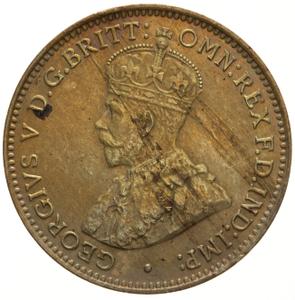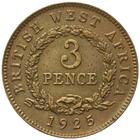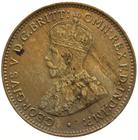The British West African Pound was the currency of British West Africa, a group of British colonies, protectorates and mandate territories - Nigeria, Sierra Leone, Ghana (originally Gold Coast) and Gambia.
The British West African Pound was equal to the (pre-decimal) Pound Sterling and was similarly subdivided into 20 shillings, each of 12 pence. In other words, the threepence (or three pence) was thus equal to a quarter of a shilling or 1/80th of a pound (i.e., 80 of these coins made one pound).
Initially the coin was equivalent to its Imperial counterpart - the British Threepence - but was then debased much earlier than it.
There were three types issued:
- silver coins - 1913 - 1920 (first sterling, then debased in 1920), for King George V
- tin brass coins - 1920 - 1936, for King George V
- copper-nickel coins - 1938 - 1957, for King George VI and Queen Elizabeth II
No 3 pence coins were issued for King Edward VIII in British West Africa.
After decolonisation, the coins were replaced by the various new countries as they introduced their own independent currencies:
- Nigeria introduced the Nigerian Pound in 1958
- Ghana introduced in Ghanaian Pound in 1958
- British Cameroon (on unification with Cameroon) adopted the Central African CFA Franc in 1961
- Sierra Leone introduced the Leone in 1964
- Gambia introduced the Gambian Pound in 1965
In some places, British West African coins circulated in parallel with the new coinage until 1968. | 





